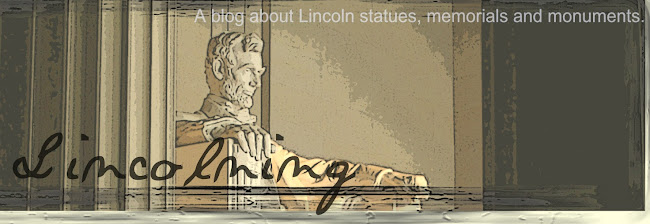
I came across the above photo on eBay not long ago and despite visiting every imaginable Lincoln statue, I could not place this particular work. It looked very familiar but I knew that I had not visited it - yet!
I watched to see if anyone else was bidding on the item. It seemed no one else was interested in the old postcard. My curiosity was really piqued and my mind was clicking through all of the large Lincoln busts I knew of and I still could not come up with the location.
I thought it had to be one of several Lincoln busts I knew but perhaps the monument had been changed in some way and didn't look like this any longer. I concluded that the statue looked like one I had seen in New Milford, CT by Paul Morris. The time period looked about right. The New Milford Lincoln was dedicated in 1912 and the folks in the picture looked from approximately the same era.
The local Historical Society in New Milford told me that the current monument had not changed since 1912. That was a trip down a dead end street.
The owner of the card told me that there were no markings or writing on the card that might indicate where the card came from. Nothing at all. No help from that quarter.
After bending my brain, it suddenly hit me where I had seen the statue before. This bust was identical to two others that I had seen. One is in Geneseo, Illinois and the other is front of the county courthouse in Hillsboro, North Dakota. I have always considered these pieces very fine portraits of Lincoln but they are virtually unknown.
Where was this one?
It was almost certainly the original bust of President Lincoln sculpted by the noted North Dakota sculptor Paul Fjelde. Fjelde had been recommended for this commission by sculptor and art historian Lorado Taft.
The bust that had been given to the City of Oslo by the Norwegian-Americans of North Dakota and Minnesota in 1914 to honor the 100th anniversary of the adoption of the Norwegian constitution which had been modeled after the U.S. Constitution.
On July 4, 1914 a committee from the United States had travelled to Norway and presented the people of Norway with this bust of Abraham Lincoln. The postcard that I purchased shows some of the dignitaries and others that attended that 1914 dedication ceremony.
I consulted with North Dakota's liaison to the Lincoln Bicentennial Commission and sent him a copy of the picture after it came in the mail. He had never seen this image but the state of North Dakota, in its archives, has images from the 1914 ceremony that show the same basic scene .
There is one very interesting aspect to the story that I should mention. It was reported that during the days of the Nazi occupation of Norway, crowds of fearless Norwegians would gather at the Lincoln bust in Oslo's Forgner Park on July 4th in silent protest.
Mystery solved and I didn't even need the History Detectives.
Additional photos of the Lincoln busts by Paul Fjelde in the United States can be found at my photo web site. The Link to the website is at the top of the page on the right.

